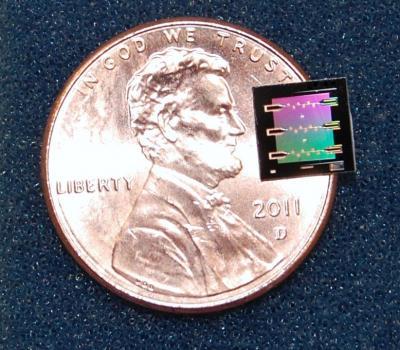BOULDER, Colo. – Showcasing new tools for widespread development of quantum circuits made of mechanical parts, scientists from the National Institute of Standards and Technology (NIST) have demonstrated a flexible, broadlyusable technique for steadily calming the vibrations of an engineered mechanical object down to the quantum "ground state," the lowestpossible energy level.
Described in a Nature paper posted online July 6,* the NIST experiments nearly stop the beating motion of a microscopic aluminum drum made of about 1 trillion atoms, placing the drum in a realm governed by quantum mechanics with its energy below a single quantum, or one unit of energy. Like aplucked guitar string that plays the same tone while the sound dissipates, the drumcontinues to beat 11 million times per second, but its range of motion approaches zero.The cooling technique and drum device together promise new machinery for quantumcomputing and tests of quantum theory, and could help advance the field of quantumacoustics exploring the quantum nature of mechanical vibrations.
NIST scientists used the pressure of microwave radiation, or light, to calm themotion of the drum, which is embedded in a superconducting circuit.** The circuit isdesigned so that the drum motion can influence the microwaves inside an electromagneticcavity. The cooling method takes advantage of the microwave light's tendency to changefrequency, if necessary, to match the frequency, or tone, at which the cavity naturallyresonates.
"I put in the light at the wrong frequency, and it comes out at the right frequency,and it does that by stealing energy from the drum motion," says John Teufel, a NISTresearch affiliate who designed the drum. Teufel led the cooling experiments in NISTphysicist and co-author Konrad Lehnert's lab at JILA, a joint institute of NIST and theUniversity of Colorado Boulder.
Compared to the first engineered object to be coaxed into the quantum groundstate, reported by California researchers last year, the NIST drum has a higher qualityfactor, so it can hold a beat longer, and it beats at a much slower rate, or lower frequency.As a result, individual packets of energy, or quanta, can be stored 10,000 times longer(about 100 microseconds)—long enough to serve as a temporary memory for a quantumcomputer and a platform for exploring complex mechanical and quantum states. Inaddition, the drum motion is 40 times greater per quantum, offering the possibility, forinstance, of generating larger entangled "cat states"—objects that are in two places atonce and also entangled, with properties that are linked even at a distance—for tests oftheories such as quantum gravity. The NIST apparatus also allows researchers tomeasure the position of the drum directly, which is useful for force detection, with aprecision closer than ever to the ultimate limit allowed by quantum mechanics.

Multiple versions of NIST's superconducting circuit containing a "micro drum" were fabricated on this sapphire chip, shown next to a penny for scale. NIST scientists cooled one such drum to the lowest possible energy level, the quantum ground state.
(Photo Credit: Teufel/NIST)
To make engineered bulk objects obey the rules of quantum mechanics, typicallyobserved only in atoms and smaller particles, scientists must lower an object'stemperature beyond the reach of conventional refrigeration. The California researcherswere able to use a passive cryogenic refrigeration technique to chill their high-frequencydevice enough to reach the ground state, avoiding the need for specialized techniques.
NIST's drum required the use of "sideband cooling" to reach much coldertemperatures, taking advantage of strong interactions between the drum and themicrowaves. This is the same idea as laser cooling of individual atoms, first demonstratedat NIST in 1978.*** Now a basic tool of atomic physics worldwide, laser cooling enabledmany significant advances by allowing researchers to reduce the vibrational motion oftrapped atoms to less than a single quantum. Sideband refers to a collection of lightparticles (photons) just above or below a specific target frequency. In the case of NIST'ssuperconducting circuit, this stray radiation pressure, as it adjusts to the surroundingenvironment of the cavity, steadily removes energy from the drum motion in the same waythat laser cooling slows atoms in a gas.
In the NIST experiments, the drum is first chilled in a cryogenic refrigerator usingliquid helium. This lowers the drum energy to about 30 quanta. Sideband cooling thenreduces the drum temperature from 20 milliKelvin (thousandths of a degree aboveabsolute zero) to below 400 microKelvin (millionths of a degree above absolute zero),steadily lowering the drum energy to just one-third of 1 quantum.
Scientists begin the sideband cooling process by applying a drive tone to the circuitat a particular frequency below the cavity resonance. The drumbeats generate sidebandphotons, which naturally convert to the higher frequency of the cavity. These photons leakout of the cavity as it fills up. Each departing photon takes with it one mechanical unit ofenergy—one phonon—from the drum motion. At a drive intensity that corresponds to 4,000photons in the cavity, the drum motion slows to less than 1 quantum. By detecting thescattered photons leaving the cavity, scientists can measure the mechanical motion nearthe lowest possible limits of uncertainty. Collectively, these steps proved that themechanical drum entered the quantum regime.
The drum apparatus has applications in quantum computers, which could somedaysolve certain problems that are intractable today, even with the best supercomputers.Quantum information can be stored in the mechanical state for more than 100microseconds before absorbing one phonon from the environment—much longer thanconventional superconducting quantum bits can maintain information. The drum, thus,might serve as a short-term memory device in a superconducting quantum computercircuit, a technology under development by the same NIST research group. In addition,because mechanical oscillators can interact with light of any frequency, they could act asintermediaries for transferring quantum information between microwave and opticalcomponents.
Source: National Institute of Standards and Technology (NIST)